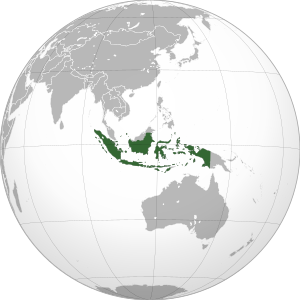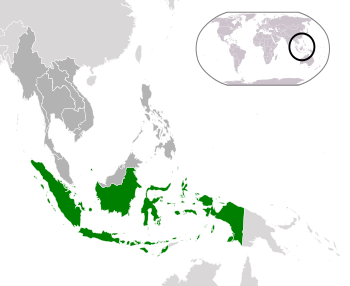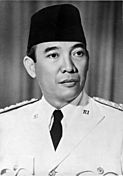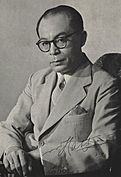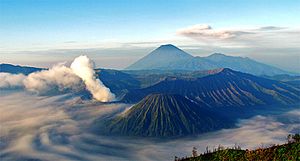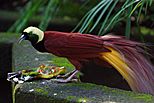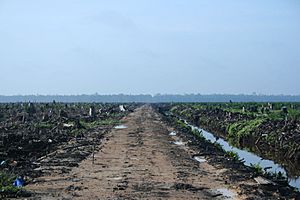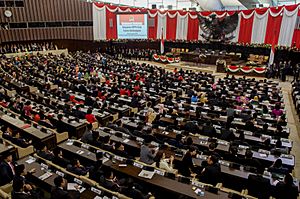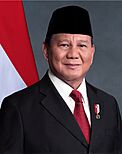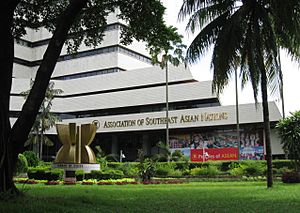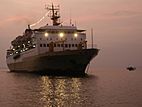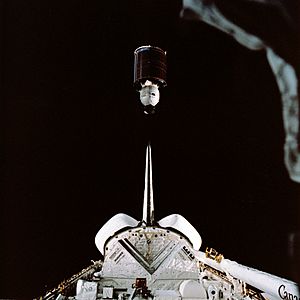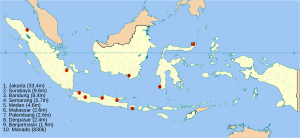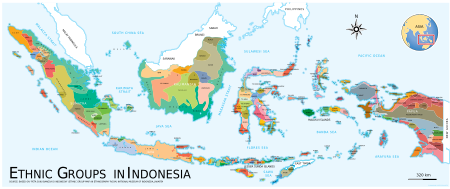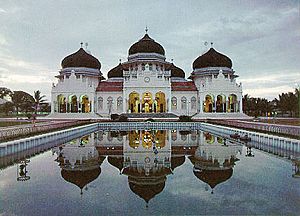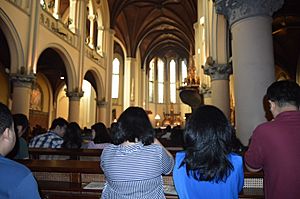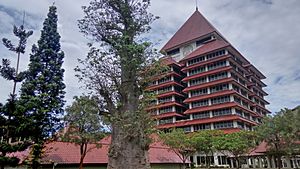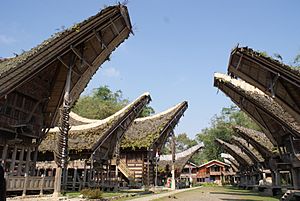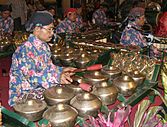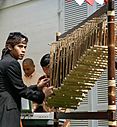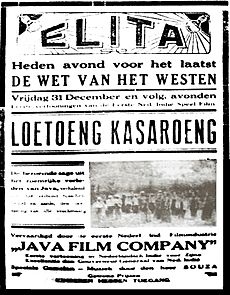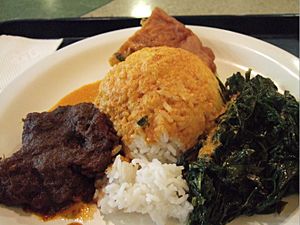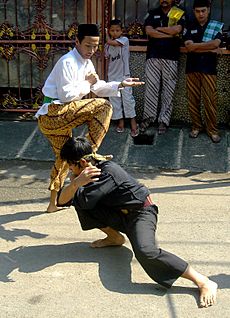Indonesia facts for kids
Quick facts for kids
Republic of Indonesia
Republik Indonesia (Indonesian)
|
|
|---|---|
|
|
|
|
Anthem: Indonesia Raya
"Indonesia the Great" |
|
| Capital and largest city
|
Jakarta 6°10′S 106°49′E / 6.167°S 106.817°E |
| Official languages | Indonesian |
| Recognised regional languages | Over 700 languages |
| Ethnic groups | Over 1,300 ethnic groups |
| Religion
(2023)
|
|
| Demonym(s) | Indonesian |
| Government | Unitary presidential republic |
| Prabowo Subianto | |
| Gibran Rakabuming Raka | |
|
• House Speaker
|
Puan Maharani |
| Legislature | People's Consultative Assembly (MPR) |
| Regional Representative Council (DPD) | |
| House of Representatives (DPR) | |
| Independence
from the Netherlands
|
|
|
• Proclaimed
|
17 August 1945 |
|
• Recognised
|
27 December 1949 |
| Area | |
|
• Total
|
1,913,580 km2 (738,840 sq mi) (14th) |
| 4.85 | |
| Population | |
|
• Q2 2024 estimate
|
|
|
• 2020 census
|
270,203,917 |
|
• Density
|
143/km2 (370.4/sq mi) (88th) |
| GDP (PPP) | 2024 estimate |
|
• Total
|
|
|
• Per capita
|
|
| GDP (nominal) | 2024 estimate |
|
• Total
|
|
|
• Per capita
|
|
| Gini (2024) | ▼ 37.9 medium |
| HDI (2022) | high · 112th |
| Currency | Indonesian rupiah (Rp) (IDR) |
| Time zone | UTC+7 to +9 (IDT) |
| Date format | DD/MM/YYYY |
| Driving side | left |
| Calling code | +62 |
| ISO 3166 code | ID |
| Internet TLD | .id |
Indonesia, officially the Republic of Indonesia (Indonesian: Republik Indonesia), is a huge island nation in Southeast Asia and Oceania. It sits between the Indian and Pacific oceans. Indonesia is made up of over 17,000 islands. Some of the biggest islands are Sumatra, Java, Sulawesi, and parts of Borneo and New Guinea.
Indonesia is the world's largest country made of islands. It is also the 14th-largest country by land area. With about 280 million people, Indonesia is the fourth-most populated country in the world. It is also the country with the most Muslim people. More than half of Indonesia's population lives on Java, which is the most populated island in the world.
Indonesia is a presidential republic. This means it has a president and an elected legislature (like a parliament). The country has 38 provinces, and nine of them have special status. Jakarta, the capital city, is the second-most populated urban area in the world. Indonesia shares land borders with Papua New Guinea, East Timor, and Malaysia. It also has sea borders with Singapore, Vietnam, Thailand, the Philippines, Australia, Palau, and India. Even with many people, Indonesia has huge wild areas. These areas are home to many different kinds of plants and animals, making it one of the world's most biodiverse countries.
The Indonesian islands have been important for trade since at least the 7th century. Back then, the Srivijaya Kingdom traded with China. Foreign powers were interested in Indonesia's natural resources. This greatly shaped its history. Early on, Hindu and Buddhist kingdoms grew strong. Later, Muslim traders brought Islam. During the Age of Discovery, European countries fought to control the spice trade in the Maluku (Spice Islands). After about 350 years of Dutch rule, Indonesia became independent after World War II.
Indonesia has thousands of different native ethnic groups and hundreds of languages. The Javanese are the largest group. People in Indonesia share a common identity with the motto "Bhinneka Tunggal Ika" ("Unity in Diversity"). This means "many, yet one." This identity comes from having a national language, many different cultures, different religions (even though most people are Muslim), and a history of fighting against colonial rule. Indonesia's economy of Indonesia is the 16th-largest in the world by its regular size (nominal GDP). It is the 7th-largest when you compare what people can buy (PPP). Indonesia is a regional power and an important country in global matters. It is a member of many international groups, like the United Nations and ASEAN.
Contents
A Quick Look at Indonesia's Name
The name Indonesia comes from old Greek words. Indos means "Indian" and nesos means "islands." So, it means "Indian islands." This name was first used in the 19th century, long before Indonesia became an independent country.
In 1850, an English expert named George Windsor Earl suggested names like Indunesians for people living in the "Indian Archipelago." Another student, James Richardson Logan, used Indonesia to mean the same thing. Dutch experts at the time preferred other names like Malay Archipelago or Netherlands East Indies.
After 1900, the name Indonesia became more popular outside the Netherlands. Local groups who wanted independence also started using it. The first Indonesian scholar to use the name was Ki Hajar Dewantara in 1913.
Indonesia's Past
Early Times
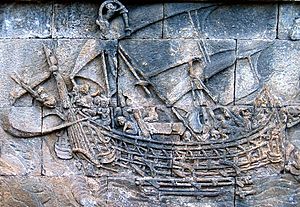
Scientists have found old bones of early humans, like "Java Man," in Indonesia. This shows people lived here about two million to 500,000 years ago. Modern humans (Homo sapiens) arrived around 43,000 BCE. Most of the people in Indonesia today are from Austronesian peoples. They came from what is now Taiwan around 2,000 BCE. They moved east, and the native Melanesians mostly stayed in the far eastern parts of the islands.
Growing rice in wet fields started very early, around 800 BCE. This helped villages and small kingdoms grow by the 1st century CE. Indonesia's location on important sea trade routes helped trade between islands and with countries like India and China. Trade has always been a big part of Indonesia's history.
From the 7th century CE, the Srivijaya sea kingdom became powerful because of trade. Hinduism and Buddhism also influenced the region. Between the 8th and 10th centuries, Buddhist Sailendra and Hindu Mataram kingdoms grew in Java. They built amazing religious sites like Sailendra's Borobudur and Mataram's Prambanan. The Hindu Majapahit kingdom started in eastern Java in the late 13th century. Under its leader Gajah Mada, its power spread across much of what is now Indonesia. This time is often called a "Golden Age" for Indonesia.
Islam first appeared in northern Sumatra in the 13th century. Over time, other parts of Indonesia also became Muslim. By the end of the 16th century, Islam was the main religion in Java and Sumatra. In most places, Islam mixed with local cultures and beliefs. This made the main type of Islam in Indonesia, especially in Java, quite unique.
Colonial Rule
The first Europeans arrived in 1512. They were Portuguese traders looking to control the spice trade in the Maluku Islands. Dutch and British traders followed. In 1602, the Dutch started the Dutch East India Company (VOC). They became the main European power for nearly 200 years. The VOC went bankrupt in 1799. Then, the Netherlands took over and made Indonesia a colony called the Dutch East Indies.
For most of the colonial period, the Dutch did not have full control. Dutch forces often had to fight rebellions. Local leaders like Prince Diponegoro in Java and Imam Bonjol in Sumatra fought against them. The long and bloody Aceh War also made the Dutch weaker. It was only in the early 1900s that the Dutch fully controlled the area that is now Indonesia.
The Japanese invasion during World War II ended Dutch rule. It also encouraged the independence movement. Two days after Japan surrendered in August 1945, Sukarno and Mohammad Hatta declared Indonesia's independence. Sukarno became the first president.
The Netherlands tried to take control again. This led to the Indonesian National Revolution. In December 1949, the Dutch finally recognized Indonesia's independence. Even with many differences, Indonesians united to fight for their freedom.
After World War II
As president, Sukarno moved Indonesia away from democracy. He kept power by balancing the military, political Islam, and the growing Communist Party of Indonesia (PKI). Tensions between the military and the PKI led to an attempted coup in 1965. The army, led by Major General Suharto, responded by removing communists. Suharto then took advantage of Sukarno's weaker position. He became president in March 1968. His government, called the "New Order," encouraged foreign direct investment. This helped Indonesia's economy grow a lot for the next 30 years.
The 1997 Asian financial crisis hit Indonesia very hard. People were unhappy with the government's corruption and lack of political freedom. This led to protests and ended Suharto's presidency. In 1999, East Timor became independent from Indonesia. Indonesia had invaded East Timor in 1975 and occupied it for 25 years.
Since 1998, Indonesia has become more democratic. It has given more power to local regions. In 2004, it held its first direct presidential election. While there have been challenges like corruption and some acts of terrorism, the economy has been strong since 2007. People from different groups mostly get along well. A peaceful solution was found for a conflict in Aceh in 2005.
Indonesia's Land and Nature
Geography of Indonesia
Indonesia is located between 11°S and 6°N latitude, and 95°E and 141°E longitude. It is a transcontinental country, meaning it spans both Southeast Asia and Oceania. It is the world's largest country made of islands. It stretches about 5,120 kilometers (3,180 miles) from east to west and 1,760 kilometers (1,090 miles) from north to south.
Indonesia has 17,504 islands, with about 6,000 of them inhabited. The largest islands are Sumatra, Java, Borneo (shared with Brunei and Malaysia), Sulawesi, and New Guinea (shared with Papua New Guinea). Indonesia shares land borders with Malaysia on Borneo, Papua New Guinea on New Guinea island, and East Timor on Timor island. It also has sea borders with Singapore, Malaysia, Vietnam, the Philippines, Palau, and Australia.
Puncak Jaya is Indonesia's highest mountain, standing at 4,884 meters (16,024 feet). Lake Toba in Sumatra is the largest lake, covering 1,145 square kilometers (442 sq mi). Indonesia's biggest rivers are in Kalimantan and New Guinea. These include the Kapuas and Barito rivers. They are important for travel and transport between towns.
Climate of Indonesia
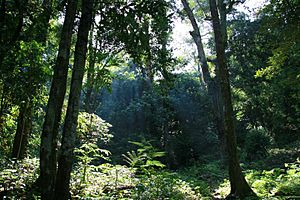
Indonesia is located along the equator. This means its climate is usually warm and stable all year round. Indonesia has two main seasons: a wet season and a dry season. There are no extreme summers or winters. For most of Indonesia, the dry season is from May to October, and the wet season is from November to April.
Indonesia's climate is almost entirely tropical. This means it has a tropical rainforest climate on all its large islands. Cooler climates can be found in mountainous areas that are 1,300 to 1,500 meters (4,300 to 4,900 feet) above sea level.
Some areas, like Kalimantan and Sumatra, have only small changes in rainfall and temperature between seasons. Other areas, like Nusa Tenggara, have bigger differences, with dry spells and floods. Rainfall varies across regions. Western Sumatra, Java, and parts of Kalimantan and Papua get more rain. Areas closer to Australia, like Nusa Tenggara, tend to be drier. The warm ocean waters around Indonesia keep land temperatures quite steady. Humidity is usually high, between 70% and 90%. Winds are generally gentle and predictable.

Experts believe Indonesia is at high risk from climate change. Rising temperatures could lead to more droughts and food shortages. Rising sea levels could also threaten many people who live near the coast. Poor communities would likely be most affected.
Geology of Indonesia
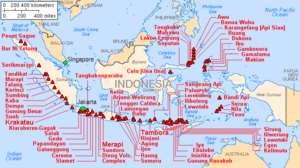
Indonesia's land is very active geologically. This means it has many volcanoes and frequent earthquakes. It sits on the Pacific Ring of Fire. This is where large pieces of the Earth's crust (tectonic plates) push against each other. A chain of volcanoes runs through Sumatra, Java, Bali, and other islands. Out of 400 volcanoes, about 130 are active.
Volcanic ash can make farming difficult in some places. However, it also creates very fertile soil. This fertile soil has helped support the large populations in Java and Bali for a long time.
A huge supervolcano erupted at what is now Lake Toba about 70,000 years ago. This eruption might have caused a "volcanic winter" and cooled the whole planet. The 1815 eruption of Mount Tambora and the 1883 eruption of Krakatoa were two of the biggest eruptions ever recorded. The Tambora eruption killed 92,000 people. The Krakatoa eruption caused 36,000 deaths and made the loudest sound in recorded history. Recent disasters from earthquakes include the 2004 Indian Ocean earthquake and tsunami and the 2006 Yogyakarta earthquake.
Amazing Plants and Animals: Biodiversity and Conservation
Indonesia's size, tropical climate, and many islands mean it has one of the world's highest levels of biodiversity. It is one of 17 "megadiverse countries." Its plants and animals are a mix of Asian and Australian types. Islands like Sumatra, Java, Borneo, and Bali were once connected to mainland Asia. They have many Asian animals like the Sumatran tiger, rhinoceros, and orangutan.
Sulawesi, Nusa Tenggara, and Maluku have their own unique plants and animals because they were separated from the main land for a long time. Papua was part of Australia. It has special animals and plants like those found in Australia, including over 600 bird species.
Indonesia has the second-highest number of endemic species (species found nowhere else). For example, 36% of its 1,531 bird species and 39% of its 515 mammal species are endemic. Indonesia's long coastline has many sea and coastal environments. These include beaches, mangroves, and coral reefs. Indonesia is part of the Coral Triangle. It has the most different kinds of coral reef fish in the world, with over 1,650 species in eastern Indonesia alone.
A British naturalist named Alfred Russel Wallace found a dividing line (Wallace Line) between Asian and Australian species in Indonesia. This line runs between Kalimantan and Sulawesi, and between Lombok and Bali. Animals and plants west of the line are usually Asian. East of the line, they become more Australian. The area of islands between his line and New Guinea is called Wallacea.
Indonesia's growing population and industries cause serious environmental problems. These include destroying peatlands, illegal deforestation (cutting down forests), and too much fishing. These issues make Indonesia rank low in environmental performance.
Indonesia has one of the fastest rates of deforestation in the world. In 2020, forests covered about 49.1% of the country's land. This is down from 87% in 1950. Cutting down trees for wood, plantations, and farming has caused much of this deforestation in Indonesia. Recently, the palm oil industry has been a big reason for this. This deforestation also threatens animals and plants found only in Indonesia. For example, the Sumatran orangutan and Javan rhinoceros are critically endangered.
How Indonesia is Governed
Government and Politics
Indonesia is a republic with a presidential system. After the fall of the New Order government in 1998, there were big changes to how the government works. Power was given to different regions, but Indonesia remained a unitary state (one united country). The President of Indonesia is the head of state and head of government. The president is also the commander-in-chief of the Indonesian National Armed Forces. The president can serve for a maximum of two five-year terms.
The highest body in the country is the People's Consultative Assembly (MPR). It can change the constitution and approve or remove the president. The MPR has two parts: the People's Representative Council (DPR) with 575 members, and the Regional Representative Council (DPD) with 136 members. The DPR makes laws and checks on the president's work. The DPD deals with regional matters.
Most disagreements between people go to the State Court. Appeals can be heard by the High Court. The Supreme Court of Indonesia is the highest court. It hears final appeals. There is also a Constitutional Court for constitutional and political issues. A Religious Court handles Islamic law cases. The Judicial Commission watches how judges do their jobs.
Political Parties and Elections
Since 1999, Indonesia has had many political parties. No single party has won a full majority of seats in elections. The Indonesian Democratic Party of Struggle (PDI-P) won the most votes in the 2019 Indonesian general election. This is the party of the current president, Joko Widodo. Other important parties include Golkar and Gerindra.
The first general election was in 1955. Before 2004, Indonesians did not directly elect their president. Now, the president is elected for a five-year term. Members of the DPR and DPD are also elected for five years. Since 2019, presidential and legislative elections are held at the same time.
Administrative Divisions

Sumatra
Sumatra
Sumatra
Java
Yogyakarta
Kalimantan
Kalimantan
Kalimantan
Maluku
Sulawesi
Papua
Papua
Papua
Papua
Papua
Indonesia has several levels of government divisions. The first level is the provinces. Each province has a legislature and an elected governor. There are 38 provinces in total. The second level is regencies and cities. These are led by regents and mayors. The third level is districts, and the fourth is villages.
The village is the smallest level of government. It is divided into community groups. Since 2001, regencies and cities are the main units for providing most government services. The village government is very important for daily life. It handles local matters through an elected village head.
Nine provinces have special status. These include Aceh, Jakarta, and Yogyakarta. Aceh can create some of its own laws based on Islamic law (sharia). Jakarta is a special city because it is the capital. Yogyakarta is the only place where a pre-colonial monarchy is still legally recognized. The leader of Yogyakarta is usually the Sultan. The six Papuan provinces give special rights to their native people in local government.
Foreign Relations
Indonesia has 132 diplomatic offices in other countries. It follows a "free and active" foreign policy. This means it wants to play a role in regional matters but avoids getting involved in conflicts between other countries.
Indonesia was an important place during the Cold War. After a political change in 1965, Indonesia changed its foreign policy. Since then, it has generally sided with Western countries while also staying non-aligned. Today, Indonesia has good relationships with its neighbors. It is a founding member of ASEAN. Indonesia does not have official diplomatic relations with Israel. It actively supports Palestine.
Indonesia has been a member of the United Nations since 1950. It was also a founding member of the Non-Aligned Movement. Indonesia is part of the World Trade Organization (WTO). It has received aid from other countries since 1967. Recently, in 2019, Indonesia started its own aid program for other countries.
Military
Indonesia's Armed Forces (TNI) include the Army, Navy (which has Marines), and Air Force. The army has about 400,000 active soldiers. In 2018, Indonesia spent 0.7% of its GDP on defense. The Armed Forces were created during Indonesia's fight for independence. They used guerrilla warfare alongside local groups.
Since then, the military has focused on keeping the country stable and protecting it from outside threats. The military had a strong political influence, especially during the New Order government. After 1998, the military's formal role in lawmaking was removed. However, it still has some political influence. Since independence, Indonesia has worked to stay united against local uprisings.
Indonesia's Economy
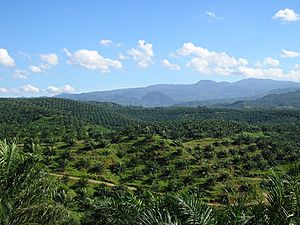
Indonesia has a mixed economy. This means both private businesses and the government play important roles. It is the largest economy in Southeast Asia and is considered a newly industrialized country. In 2023, Indonesia was the 16th largest economy in the world by its regular size (nominal GDP). It was the 7th largest when comparing what people can buy (PPP).
Services are the biggest part of Indonesia's economy. They make up 43.4% of the GDP. Industry is next at 39.7%, and agriculture is 12.8%. Since 2009, the service sector has employed the most people.
The economy has changed a lot over time. It used to rely heavily on agriculture. In the late 1960s, Indonesia started to industrialize and urbanize. This sped up in the 1980s when oil prices dropped. The government then focused on making and selling other products. This helped the economy grow by about 7.1% each year. The number of people living in poverty fell from 60% to 15%.
The 1997 Asian financial crisis hit Indonesia's economy hard. But since 2007, the economy has grown strongly. This is thanks to improvements in banking and people buying more goods. In 2019, 9.41% of the population lived below the poverty line. The unemployment rate was 5.28%. The economy faced a setback during the COVID-19 pandemic but recovered the next year.
Indonesia has many natural resources. Its main industries include fishing, oil, timber, and paper products. Key agricultural products are rice, coconuts, coffee, and palm oil. Palm oil and coal are major exports. Indonesia mainly imports telephones, car parts, and wheat. Its main trading partners are China, the United States, Japan, and Singapore.
Transportation in Indonesia
Indonesia's transport system is shaped by its many islands and where its 275 million people live. Roads are the most common way to travel. In 2018, there were 542,310 kilometers (336,975 miles) of roads. Jakarta has the longest bus rapid transit system in the world. Small vehicles like bajaj and becak (rickshaws) are common. Shared taxis like Angkot are also popular.
Most railways are on Java. Some are in Sumatra. They are used for both goods and passengers. Commuter trains run in Greater Jakarta and Yogyakarta–Solo. Jakarta and Palembang were the first cities to have rapid transit systems. In 2015, the government announced plans for a high-speed rail. This would be the first in Southeast Asia.
Indonesia's largest airport is Soekarno-Hatta International Airport. It is one of the busiest in the Southern Hemisphere. Garuda Indonesia is the country's main airline. It is a member of the global airline alliance SkyTeam. The Port of Tanjung Priok is Indonesia's busiest port. It handles over 50% of the country's cargo.
Energy in Indonesia

In 2019, Indonesia produced and used a lot of energy. The country has many energy resources. These include oil, gas, and coal.
By late 2020, Indonesia's total power generation capacity was 72,750.72 megawatts. Indonesia has been using more coal and imported oil. However, it has also made progress in renewable energy. Hydropower and geothermal energy are the most common renewable sources. They make up over 8% of the country's energy mix. The Jatiluhur Dam is Indonesia's largest dam. It has a capacity of 186.5 megawatts and helps power Java. Indonesia also has potential for solar, wind, and ocean energy. But these sources are still small.
Science and Technology in Indonesia
Indonesia spends a small amount on research and development. In 2021, it ranked 87th out of 132 economies in the Global Innovation Index. Some historical examples of Indonesian technology include the terasering (terraced farming) technique. The pinisi boats built by the Bugis and Makassar people are also famous. In the 1980s, Indonesian engineer Tjokorda Raka Sukawati invented a road construction technique called Sosrobahu. This technique is now used in several countries.
Indonesia also builds passenger trains and freight wagons. Its state-owned company, INKA, has exported trains to other countries. Indonesia is the only country in Southeast Asia that builds its own aircraft. The state-owned Indonesian Aerospace company makes parts for Boeing and Airbus. It also worked with Spain to develop the CASA/IPTN CN-235 aircraft. Former President B. J. Habibie was very important in this achievement. Indonesia is also helping South Korea build the KF-21 Boramae fighter jet.
Indonesia has its own space program and space agency, LAPAN. In the 1970s, Indonesia became the first developing country to use its own satellite system called Palapa. These satellites are used for communication. The first Palapa satellite was launched in 1976 from Florida, USA. By 2019, Indonesia had launched 18 satellites for different purposes.
Tourism in Indonesia

Tourism brought in about $9.8 billion to Indonesia's economy in 2020. In 2019, 15.4 million visitors came to Indonesia. Most visitors come from China, Singapore, Malaysia, Australia, and Japan. Since 2011, "Wonderful Indonesia" has been the country's slogan to promote tourism.
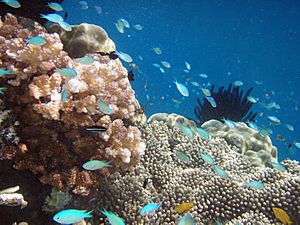
Nature and culture are the main reasons people visit Indonesia. The country has beautiful rainforests covering about 57% of its land. These include places like the Orangutan wildlife reserve in Sumatra and Kalimantan. Indonesia also has one of the world's longest coastlines, measuring 54,716 kilometers (34,000 miles).
Ancient temples like Borobudur and Prambanan are popular cultural sites. Toraja and Bali are also famous for their traditional festivals. Indonesia has nine UNESCO World Heritage Sites. These include Komodo National Park and the Sawahlunto Coal Mine. Other attractions include colonial buildings in Jakarta and Semarang. Royal palaces like Pagaruyung and Ubud are also popular.
People and Culture
Demographics of Indonesia
The 2020 census counted 270.2 million people in Indonesia. This makes it the fourth largest population in the world. The population is growing at a moderate rate. Java is the world's most populated island, with 56% of Indonesia's people living there. The average number of people per square kilometer is 141. But on Java, it's much higher, at 1,067 people per square kilometer.
In 1961, the first census after independence counted 97 million people. The population is expected to reach about 295 million by 2030. Indonesia has a relatively young population, with an average age of 30.2 years in 2017.
The population is spread unevenly. Some areas are huge cities like Jakarta. Others have uncontacted tribes in Papua. As of 2017, about 54.7% of people live in urban areas. Jakarta is the country's largest city. It is the second-most populated urban area globally, with over 34 million residents. About 8 million Indonesians live overseas. Most of them live in Malaysia, the Netherlands, and Saudi Arabia.
|
Largest cities in Indonesia
2023 BPS estimate |
||
|---|---|---|
| Rank | Name | Pop. |
| 1 | Jakarta | 11,350,328 |
| 2 | Surabaya | 3,009,286 |
| 3 | Bekasi | 2,627,207 |
| 4 | Bandung | 2,506,603 |
| 5 | Medan | 2,494,512 |
| 6 | Depok | 2,145,400 |
| 7 | Tangerang | 1,912,679 |
| 8 | Palembang | 1,729,546 |
| 9 | Semarang | 1,694,740 |
| 10 | Makassar | 1,474,393 |
Ethnic Groups and Languages
Indonesia is a country with many different ethnic groups. There are about 1,300 distinct native groups. Most Indonesians are descended from Austronesian peoples. Their languages came from a very old language called Proto-Austronesian, which might have started in Taiwan. Another main group is the Melanesians. They live in eastern Indonesia, like the Maluku Islands and Western New Guinea.
The Javanese are the largest ethnic group. They make up 40.2% of the population and are politically powerful. They mostly live in central and eastern Java. The Sundanese are the next largest group (15.4%). Other big groups include Batak, Madurese, and Minangkabau. Indonesians feel a sense of national identity, but they also have strong local identities.
The official language of Indonesia is Indonesian. It is a form of Malay. This language has been used for trade and communication in the islands for centuries. Nationalists promoted it in the 1920s. It became the official language in 1945. Indonesian has many words from local and foreign languages. Almost everyone in Indonesia speaks Indonesian. This is because it is used in schools, business, and media. Most Indonesians also speak at least one of over 700 local languages. Javanese is the most widely spoken local language. It is also an official language in Yogyakarta.
Historically, the number of Dutch and other Europeans in Indonesia was very small. The Dutch language never became widely spoken or official, even after almost 350 years of Dutch rule. This shows that the Dutch colonial empire was mainly focused on trade, not on making everyone speak Dutch. Today, only a few older, educated people or legal professionals can speak Dutch.
Religion in Indonesia
Indonesia's constitution guarantees religious freedom. However, the government officially recognizes only six religions: Islam, Protestantism, Roman Catholicism, Hinduism, Buddhism, and Confucianism. Indigenous religions are partly recognized. With 231 million followers (86.7%) in 2018, Indonesia is the world's most populous Muslim-majority country. Most Muslims are Sunnis. About 10% of Indonesians are Christians. They are the majority in some eastern provinces. Most Hindus are Balinese, and most Buddhists are Chinese Indonesians.
The native people of Indonesia originally practiced animism and dynamism. They believed that spirits lived in nature, like trees and mountains. Examples of these beliefs include Sunda Wiwitan and Kaharingan. These old beliefs have greatly influenced how other faiths are practiced in Indonesia. Many people mix their main religion with these older traditions.
Hindu influences reached Indonesia as early as the 1st century CE. Buddhism arrived around the 6th century. Both religions have a shared history in Indonesia. Powerful Hindu and Buddhist empires like Majapahit and Srivijaya rose and fell here. Even though they are no longer the majority, Hinduism and Buddhism still have a big impact on Indonesian culture.
Islam was brought by traders from India and Arabia as early as the 8th century CE. Islam mostly mixed with existing cultures and religions. This created a unique form of Islam. Trade, missionaries, and military campaigns helped Islam spread quickly. By the end of the 16th century, Islam had replaced Hinduism and Buddhism as the main religion in Java and Sumatra.
Catholicism was brought by Portuguese traders and missionaries. Protestantism came mostly from Dutch missionaries during the colonial era.
Indonesia's leaders and community groups play a big role in relations between different faiths. The first principle of Indonesia's national philosophy, Pancasila, reminds people about religious tolerance. This principle is "belief in the one and only God." Most Indonesians believe religion is a very important part of life.
Education and Health
Education is required for 12 years in Indonesia. Parents can choose between public schools or private religious schools. There are also private international schools. In 2018, 93% of children were in primary school. 79% were in secondary school, and 36% were in higher education. The literacy rate was 96% in 2018. The government spent about 3.6% of its GDP on education in 2015. In 2018, Indonesia had 4,670 higher education institutions. Most of them are in Sumatra and Java. Top universities include the University of Indonesia and Gadjah Mada University.
The government spent about 3.3% of its GDP on healthcare in 2016. In 2014, the government started a National Health Insurance program. This program aims to provide healthcare for everyone. Life expectancy has increased from 62.3 years in 1990 to 71.7 years in 2019. Child mortality has also decreased. However, challenges remain, such as maternal and child health, air quality, and malnutrition.
Indonesian Culture
Art and Architecture
Indonesian arts include very old forms and newer contemporary art. Indonesian arts have been influenced by India, the Arab world, China, and Europe. This is because of trade and interactions over time. Today, Indonesia has a mix of many cultures, languages, and ethnic groups. Indonesia has twelve items recognized by UNESCO as important cultural heritage. These include wayang puppet theatre, kris (a special dagger), batik cloth, pencak silat martial art, angklung musical instrument, gamelan music, and three types of traditional Balinese dance.
Many megalithic sculptures have been found in Indonesia. Tribal art is also strong among groups like the Nias, Batak, and Toraja. Wood and stone are often used for sculpting. Between the 8th and 15th centuries, the Javanese people developed beautiful stone sculptures and buildings. The temples of Borobudur and Prambanan are famous examples.
Indonesian architecture has also taken in foreign influences. These have changed building styles and techniques. Indian influences have been the strongest. But Chinese, Arab, and European styles have also been important. Traditional carpentry and stonework are still used. There are many styles of traditional houses (rumah adat). Each ethnic group has its own unique customs and history for their houses. Examples include Toraja's Tongkonan and Minangkabau's Rumah Gadang.
Music, Dance, and Clothing
Indonesian music is very old. Many native tribes use chants and songs with musical instruments in their ceremonies. Angklung, gamelan, and sasando are examples of traditional Indonesian instruments. Indonesian music has many different styles. This is because of the creativity of its people and influences from other cultures. These include Middle Eastern, Portuguese, and Indian influences. Dangdut is one of Indonesia's most popular music styles. Today, Indonesian music is popular in Malaysia, Singapore, and Brunei too.

Indonesian dances have a rich history, with over 3,000 original dances. Many dances started as rituals or religious worship. Examples include war dances and dances to ask for rain. Indonesian dances get their influences from ancient tribal times, Hindu-Buddhist periods, and Islamic periods. Modern dances are also popular now. But many traditional dances, like those from Java, Bali, and Dayak, are still alive and practiced.
Indonesia has many different clothing styles. These come from its long and rich cultural history. The national costume comes from the country's native culture and traditional textiles. The Javanese Batik and Kebaya are probably Indonesia's most famous national costumes. Each province has its own traditional clothes. People wear national and regional costumes for weddings, ceremonies, and special events.
Theatre and Cinema
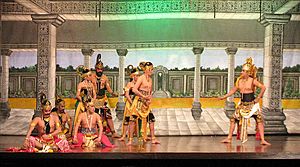
Wayang is a Javanese, Sundanese, and Balinese shadow puppet theatre. It tells old stories like the Ramayana and Mahabharata. Other local plays include Javanese Ludruk and Ketoprak. These plays often include humor and involve the audience. Some theatre traditions also have music, dancing, and silat martial arts. Modern performing arts have also grown in Indonesia.
The first film made in Indonesia was Loetoeng Kasaroeng in 1926. The film industry grew after independence. Usmar Ismail is seen as a pioneer of Indonesian films. During the later years of Sukarno's rule, films were used to promote national pride. Foreign films were banned. The Suharto government used censorship to maintain social order. Film production was highest in the 1980s.
Since 1998, independent films have helped the film industry grow again. Films started to talk about topics that were previously not allowed, like religion and love. Between 2000 and 2005, more films were released each year. KKN di Desa Penari broke box office records in 2022. It became the most-watched Indonesian film. Indonesia holds annual film festivals and awards, like the Indonesian Film Festival.
Mass Media and Literature
Media freedom greatly increased after the fall of the New Order government. Before that, the government controlled local media and limited foreign media. Now, there are many national and local TV networks. They compete with the public TVRI channel. By the early 21st century, TV signals reached every village. People can choose from up to 11 channels. Private radio stations broadcast news. The number of printed newspapers and magazines has also grown a lot since 1998.
Indonesia started developing the Internet in the early 1990s. Its first commercial Internet service provider began in Jakarta in 1994. In 2018, Indonesia had 171 million Internet users. This number keeps growing every year. Most users are between 15 and 19 years old. They mainly use mobile phones to access the Internet.

The oldest writings found in Indonesia are Sanskrit inscriptions from the 5th century. Many Indonesian peoples have strong oral traditions. These traditions help keep their cultural identities alive. In written poetry and stories, several traditional forms are common. These include syair, pantun, and hikayat.
Early modern Indonesian literature comes from Sumatra. Literature and poetry grew strong in the decades before and after independence. The government created Balai Pustaka in 1917 to help local literature grow. Many experts think the 1950s and 1960s were the Golden Age of Indonesian Literature. The style of modern Indonesian literature changes with the country's political and social changes. Important writers include Pramoedya Ananta Toer and Ayu Utami.
Delicious Indonesian Food
Indonesian food is very diverse and flavorful. Many regional cuisines exist. They are often based on local culture and foreign influences from China, Europe, the Middle East, and India. Rice is the main staple food. It is served with meat and vegetable side dishes. Spices (especially chili), coconut milk, fish, and chicken are key ingredients.
Some popular dishes are nasi goreng (fried rice), gado-gado (vegetable salad with peanut sauce), sate (grilled skewers), and soto (soup). These are found everywhere and are considered national dishes. In 2014, the Ministry of Tourism chose tumpeng (a cone-shaped rice dish) as the official national dish. It represents the diversity of Indonesian food. Other popular dishes include rendang, a spicy meat dish from the Minangkabau people. Another fermented food is oncom, which is similar to tempeh.
Sports in Indonesia
Badminton and football are the most popular sports in Indonesia. Indonesia is one of the few countries that have won the Thomas Cup and Uber Cup. These are the world championships for men's and women's badminton teams. Badminton, along with weightlifting, has brought Indonesia the most Olympic medals. Liga 1 is Indonesia's top football league.
On the international stage, Indonesia was the first Asian team to play in the FIFA World Cup in 1938. Regionally, Indonesia has won bronze and gold medals at the Asian Games and Southeast Asian Games (SEA Games). Indonesia first played in the AFC Asian Cup in 1996.
Other popular sports include boxing and basketball. Sepak takraw (a game like volleyball played with feet) and karapan sapi (bull racing) in Madura are traditional Indonesian sports. In some areas, mock fighting contests are held, like caci in Flores. Pencak Silat is an Indonesian martial art. In 2018, it became an event in the Asian Games. Indonesia is one of the top sports countries in Southeast Asia. It has topped the SEA Games medal table ten times since 1977.
Images for kids

Sumatra
Sumatra
Sumatra
Java
Yogyakarta
Kalimantan
Kalimantan
Kalimantan
Maluku
Sulawesi
Papua
Papua
Papua
Papua
Papua
See also
 In Spanish: Indonesia para niños
In Spanish: Indonesia para niños




